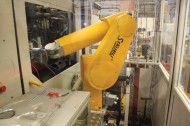 ‘Neighbours, everybody needs good neighbours’ goes that vaguely-familiar theme tune, although in this instance the neighbours are two cutting-edge businesses in trendy Totnes, Devon.
‘Neighbours, everybody needs good neighbours’ goes that vaguely-familiar theme tune, although in this instance the neighbours are two cutting-edge businesses in trendy Totnes, Devon.
Inject Plastics is a trade injection moulder producing a huge variety of plastic parts, whilst literally across the road is Barr & Paatz, a leading industrial robotics specialist. With one company committed to high technology production and the other specialising in process automation, it was almost inevitable that their paths would cross commercially.
Not unusually, the project in question concerned programming a robot for high speed, high precision work, in a fully automated workcell. Less commonly, it involved a powerful 6-axis robot already installed alongside an injection moulding machine, rather than designing the cell layout from scratch.
A family-owned business established in 1986, Inject Plastics is based in a modern 13,000sq ft factory on the town’s industrial estate, adjacent to the Barr & Paatz premises. It invests continually in leading edge technology and is equipped with the latest microprocessor-controlled Demag injection moulding machines, with clamping forces ranging from 35 tonnes to 300 tonnes, enabling it to produce plastic parts up to a kilogram in weight. Unlike many injection moulding companies, which tend to employ simple 3-axis Cartesian fixed automation systems for demoulding, Inject Plastics also boasts a 6-axis, Stäubli RX 90L industrial robot, with a reach of almost 1200mm, a maximum payload capacity of 6kg and an impressive repeatability of ±0.025mm.
“Cartesian systems are OK for loading and unloading, but not sufficiently adaptable to perform the other operations and movements frequently required, such as rotating the moulding or assembling components,” says Inject Plastics MD, Richard Bromley. “A six-axis robot, with its full range of accurate and repeatable motion over a wide work envelope, provides the ideal, cost-effective automation solution.”
Industrial robots can also be reprogrammed and redeployed for other processing tasks, an inherent flexibility that was exploited by Barr & Paatz on this project. On behalf of a trade customer, Inject Plastics produces precision mouldings for scratch-resistant safety goggles and the Stäubli robot was previously used as a pick & place device in a process that involved laying paper-thin plastic film inside the moulding tool and injecting plastic onto the back. However, a product redesign necessitated adding film to both faces of the optical moulding, creating a three-layer sandwich, which meant fully automating the more complex process.
“Since Barr & Paatz is an authorised Stäubli integrator, knows the robot configuration well and has in-depth programming experience, we turned to our neighbours for expert help,” says Richard. “We’re more than happy with the work they’ve done and now they’re the first people we talk to regarding other process automation applications.”
Since the robot and some safety guarding were already installed, revising the whole cell layout for optimum performance was impractical, so Barr & Paatz had to work within existing parameters and add ancillary equipment for such functions as film handling, bonding and gate cropping. The robot specialists also incorporated new loading mechanisms, extra guarding and safety interlocks, as well as air filtration equipment that enables the workcell to operate in a dust-free environment.
The moulded goggle lenses are curved to eliminate optical distortion, but the robot starts by configuring the end-of-arm tooling to pick up flat plastic film, which is achieved by first docking the tool into a custom-powered drive configuration that mechanically flattens the shape. Once the tool is in the flat figuration, the robot collects two separate strips of plastic film, one on either side, then returns to the drive station to reconfigure the tool into a curved format.
When the moulding machine is open and ready, the robot rotates the end effector 90º and removes the finished product by means of vacuum cups, then flips back 90º and loads the new film onto each face of the mould, ready to produce the next three-layer optical lens. Finally, the robot deposits the finished product onto the exit conveyor and is ready to start the whole cycle again.
“The whole process is completed without the product being touched by human hand, which contributes to its optical integrity. Quite frankly, it would be impossible to produce these parts to the required standard and in the quantities involved, using manual procedures,” concludes Richard.
“Robotics eliminates the costly labour element from the process and it’s fair to say that the operator’s skill set has actually increased, since he has had to become familiar with the working kinematics of the robot.”
Barr & Paatz
Tel: 01803 869 833
Email s.paatz@barr-paatz.co.uk





Comments are closed.